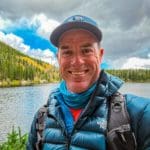|
Getting your Trinity Audio player ready...
|
Established in 1968
The North Cascade Range is a haven for countless plant species in this national park. The untouched wilderness takes you back to a time before human civilization, with roaring waterfalls, dazzling stars, and natural boundaries of trees and mountains.
Overview
Hidden within the rugged landscape of Washington’s northwest region lies a sprawling expanse of adventure: North Cascades National Park. This vast area, spanning over 500,000 acres, was established on October 2, 1968 and is part of the thrilling North Cascades National Park. From Ross Lake to Lake Chelan, this park boasts jagged peaks, deep valleys, cascading waterfalls, and over 300 glaciers that all beckon to be explored. And with diverse ecosystems adapted to both moisture and fire, embarking on a journey through this untamed wilderness is sure to ignite your sense of adventure.
Embark on a thrilling journey through North Cascades National Park, where endless possibilities await. From hiking and camping to backpacking and mountaineering, the park offers endless adventures. With over 400 miles of trails to explore, adrenaline junkies can find their next fix with day hikes or multi-day expeditions into the untamed wilderness. Don’t miss out on the breathtaking views from the Maple Pass Loop and Sahale Arm hike – two must-see paths in the heart of the North Cascades.
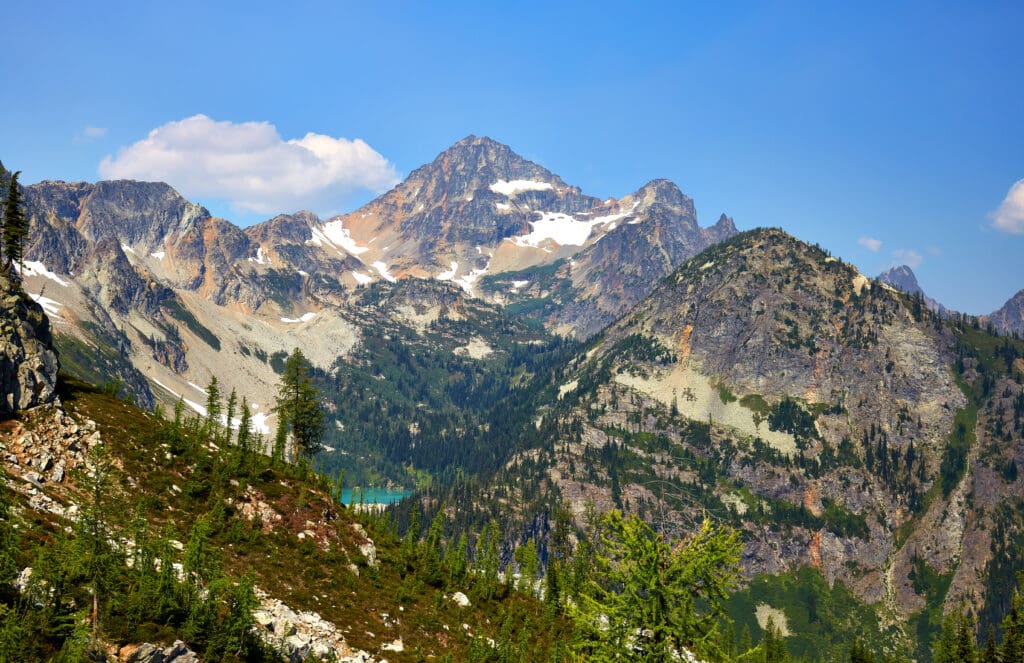
View of Black Peak (located in North Cascades National Park) from the Maple Pass hiking trail near Rainy Pass, Washington
Photo: Sean Board/Adobe Stock.
The park is also home to a variety of wildlife, including wolves, lynx, and moose. It is sensitive to the Earth’s changing climate, with the landscape and ecosystems being particularly affected by these changes.
For those looking to visit, the primary access to the North Cascades National Park and Ross Lake National Recreation Area is off of State Route 20, which connects to I-5 (Exit 230) at Burlington. The park is about 115 miles from Seattle. It’s worth noting that from November through April, State Route 20 is closed from Ross Dam to the west due to winter conditions.
Camping options near the park complex include car-accessible campgrounds and backcountry camping, catering to a range of preferences and comfort levels. Reservations for backcountry permits start in March 2024, and it’s advised to plan ahead for both non-peak and peak season visits.
In summary, North Cascades National Park is a vast and diverse wilderness area that offers a wealth of recreational opportunities and stunning natural beauty. It’s a must-visit for nature lovers, hikers, and anyone looking to explore the rugged landscapes of the Pacific Northwest.
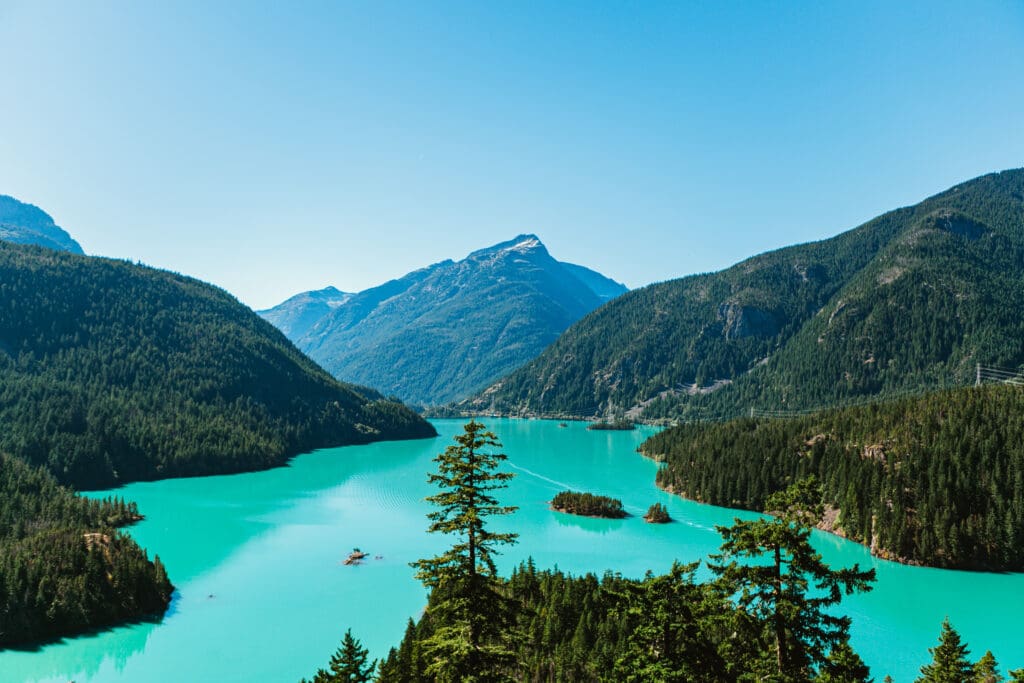
The Ross Lake Reservoir in the North Cascades in National Park. Washington. Photo: Joel Hartz/Wirestock/Adobe Stock.
Table of Contents
Article Navigation: Click on any of the listed items in the table of contents below to jump to that section of the article. Similarly, clicking on any large, white section header will jump you back to the Table of Contents.
Planning A Summer Weekend Getaway in Methow Valley, Washington
History
Long before Europeans began exploring the region, the North Cascades was home to the Paleo-Indian Native Americans. Scientists estimate that humans have inhabited the surrounding region for around 9,000 years. It is likely that the Paleo-Indians arrived in the North Cascades from the Puget Sound. Microblades found throughout the park date back to over 9,000 years ago, helping researchers distinguish five unique cultural periods of the past. Because of how rugged the peaks of the North Cascades are, the Skagit tribes primarily inhabited the western slopes of the park, exploring the mountains during the summer months when snowfall had diminished.
European colonizers first arrived in the North Cascades region around 1810. A camp was set up soon after to explore the region and expand the growing fur trade of the time. For many decades fur trapping was the only reason Europeans were inhabiting the region. But with the expansion of the railroad in the 1850’s more settlers began moving into the area. Though no railroad was built through the North Cascades, as they were deemed too dangerous, the population of the region began to grow.
Mining continued to grow from the 1890s into the 1940s, which helped create some of the first trails in the park. While many sections of the Pacific Northwest were used extensively for logging, the North Cascades jagged peaks helped deter major logging companies.
Environmentalists and activists of Washington comprehended the natural beauty of the region and wanted to protect it by establishing a national park. Local populations often said that the region had beauty “greater than Switzerland”. Efforts began as early as 1892, continuing through the first few decades of the 1900s. Finally, President John F. Kennedy approved the region as a National Park in the early 1960’s, with official designation taking place in 1968.
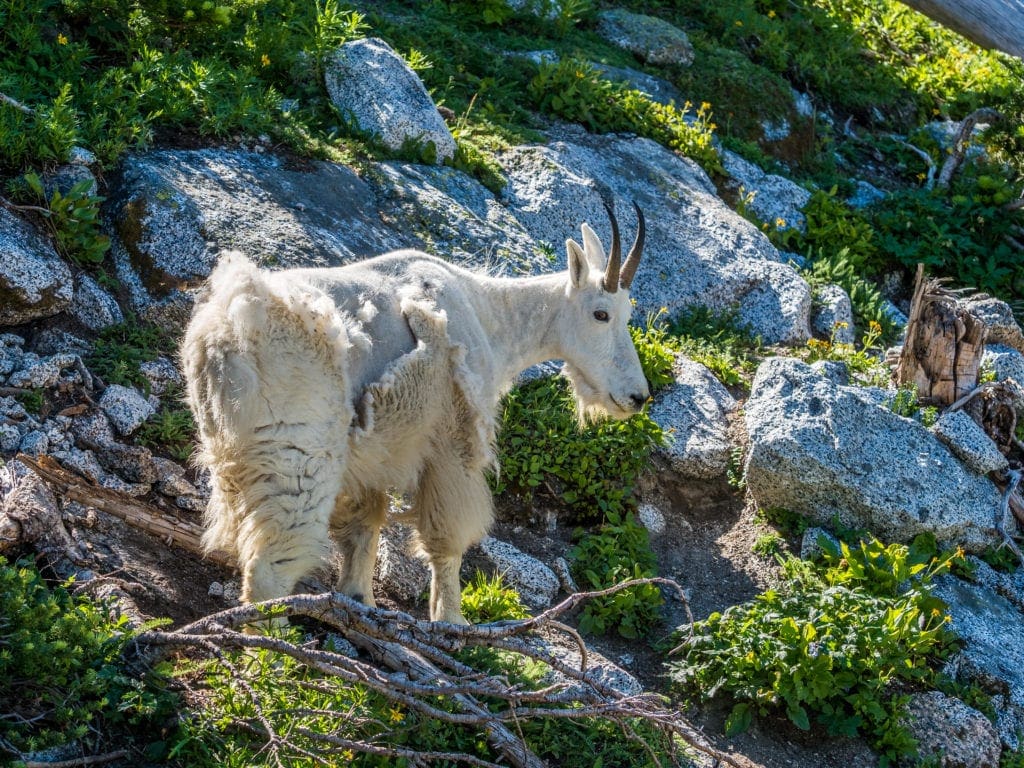
White mountain goat in North Cascades National Park, Washington.
Geology, flora, fauna
The Skagit river runs through the park, separating the Northern Unit from the Southern Unit. Because the park straddles the Cascade Range it offers a diverse landscape. The western slopes are characteristic of western Washington. High rainfall leads to lush forest and an abundance of flora. The eastern region of the park is more dry with less dense forests and more exposed peaks.
The park boasts 9,000 feet of vertical relief and lies just east of Mount Baker. Glacial retreat over time has carved the rugged peaks that distinguish the park from any other in the nation. The park is home to some of the steepest mountain ranges in the United States along with over 300 glaciers. On top of the immense amount of glaciers, the park is also home to over 300 lakes, containing the headwaters for both the Stehekin and Nooksack Rivers.
The peaks of the park are made up mostly of Mesozoic crystalline and metamorphic rock whose continually reformation has led to the park being one of the most complex geological formations in all of North America. The tallest peak in the park in Good Mountain, standing at 9,220 feet in the southern region of the park. North Cascades National Park is home to seemingly endless peaks reaching over 8,400 feet.
Another notable peak, in the northwestern section of the park, is Mount Shuksan standing at 9,131 feet. To comprehend just how steep some of the peaks are, many turn to the iconic Mount Shuksan. Though the peak is just over 9,000 feet tall, it towers above Baker Lake by nearly 8,400 feet. The lake lies just six miles away from the base of the iconic peak.
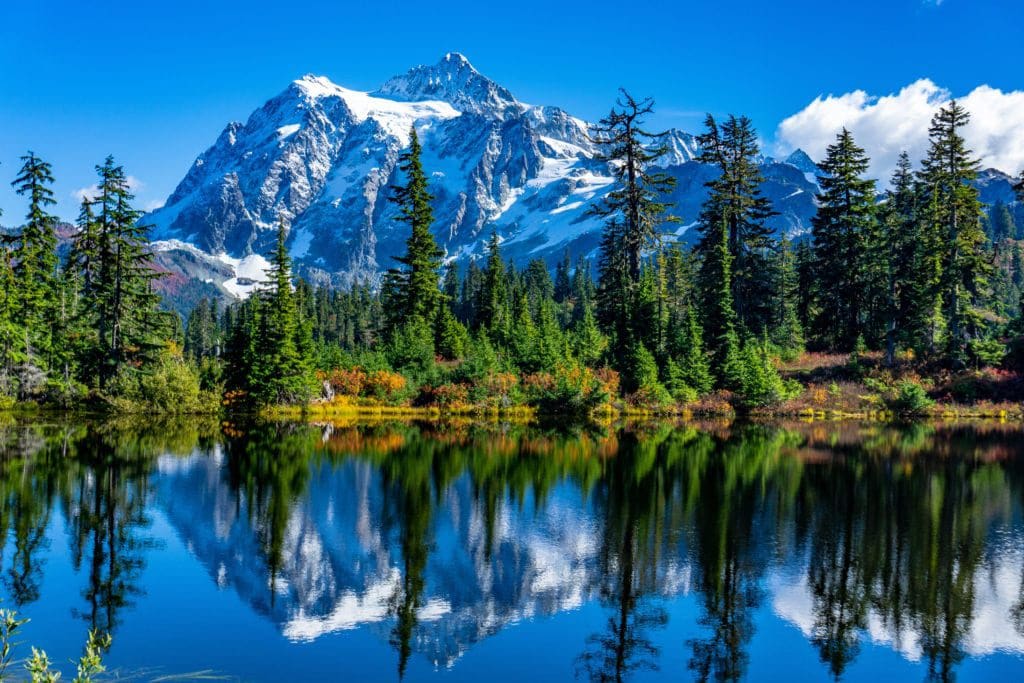
Lake Reflection of Mount Shuksan in North Cascades National Park, Washington.
The 312 glaciers of the park make it the most glaciated park outside of Alaska. Over a third of the glaciers that lie within the lower 48 states can be found within the park’s boundaries. Because the park is so glaciated, it is home to one of the oldest research stations in the country that is tracking glacial retreating.
Steep and rugged peaks, along with high amounts of rainfall, allow for various flora and fauna to thrive throughout the North Cascades National Park. Over 1,600 plant species, excluding fungi and non-vascular, have been found throughout the park. Old growth forest covers nearly half of the 500,000 acres of the region. These old forests are made primarily of Douglas fir and western hemlock trees. As elevations rise, older forests give way to pacific silver fir and mountain hemlock. Between 4,000 and 7,000 feet, the forests finally begin to thin while grasses and shrubs dominate the landscape amidst the many lakes. White bark pine is native to the region though threatened by white pine blister runs and the mountain pine beetles.
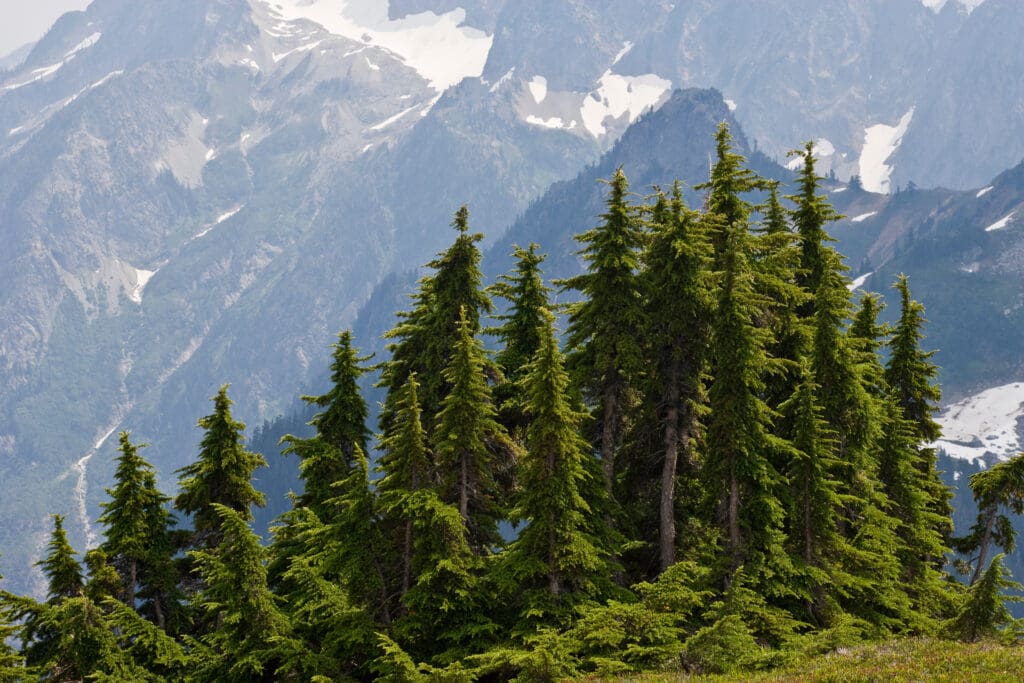
Mountain hemlock trees near Cascade Pass in North Cascades National Park. Photo: Don Paulson / Jaynes Gallery / Danita Delimont / Adobe Stock.
Despite the immense amount of biodiversity, invasive species and climate change threaten the pristine park. Diffuse knapweed and reed canary grass threaten the native species of the park while warmer temperatures lead to forest fires and faster melting glaciers.
Because so much of the park is protected by wilderness, the relatively unexplored terrain allows for animals to thrive. North Cascades National Park is home to over a dozen carnivore species including cougar, bobcat, mink, coyote, black bear, and river otters. Other large mammals include elk, deer, mountain goat, moose, bighorn sheet, beaver. Both grey wolves and grizzly bears inhabit regions of the park with the wolf being classified as an endangered species.
The grizzly bear was extirpated during the 1860s and there have only been two sightings in recent decades. However, there are plans to reintroduce the grizzly bear to the region. Wolverines also inhabit the park though they are known for being one of the most elusive species in all of North American.
The park is also home to over 200 species of birds. Both golden and bald eagles roam the sky along with northern spotted owl, trumpeter swan, harlequin duck, and various others. The endangered peregrine falcon finds protection from the park as the endangered species works at rebuilding its population. The waterways of the park are home to all five species of Pacific salmon including pink, coho, chum, sockeye, and chinook. Various species of trout and bass can also be found in the lakes and rivers of the park.
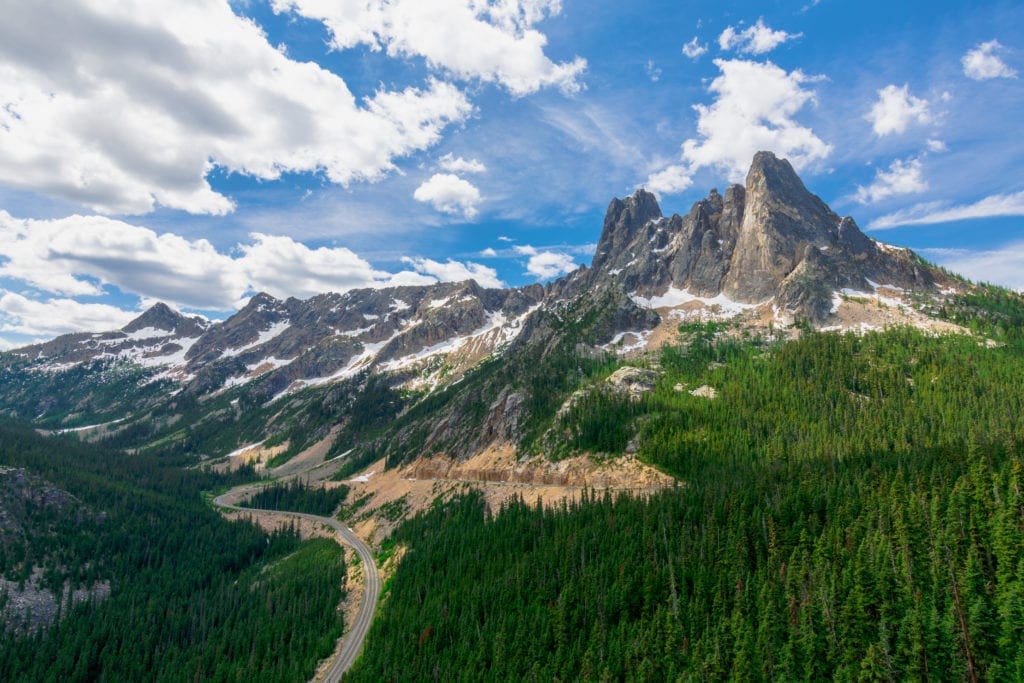
Washington Overlook in North Cascades National Park, Washington.
Glaciers
North Cascades National Park boasts an impressive 312 glaciers, the most of any national park in the US outside of Alaska. Combined with a few glaciers in neighboring National Recreation Areas, the North Cascades National Park Complex is home to a total of 27,000 acres (110 km2) of glacial coverage as of 2009.
The largest glacier in the park is Boston Glacier, located on the north slope of Boston Peak and measuring at 1,730 acres (7.0 km2) in 1971. Other notable glaciers include East Nooksack and Sulphide Glaciers on Mount Shuksan, McAllister and Inspiration Glaciers on Eldorado Peak, Redoubt Glacier on Mount Redoubt, Neve Glacier on Snowfield Peak, and Challenger Glacier on Mount Challenger, all measuring over 2 square kilometers (0.77 sq mi) in 1971.
According to the NPS, this loss of glacial ice can be attributed to a 40% decrease in volume over the last 150 years – a period that coincides with the end of the Little Ice Age, a cooling phase that lasted several centuries. This loss of glacial ice has led to reduced melt during summer months. A paper published in 2016 reported a 25% reduction in summertime streamflow in the Skagit River watershed since 1959.
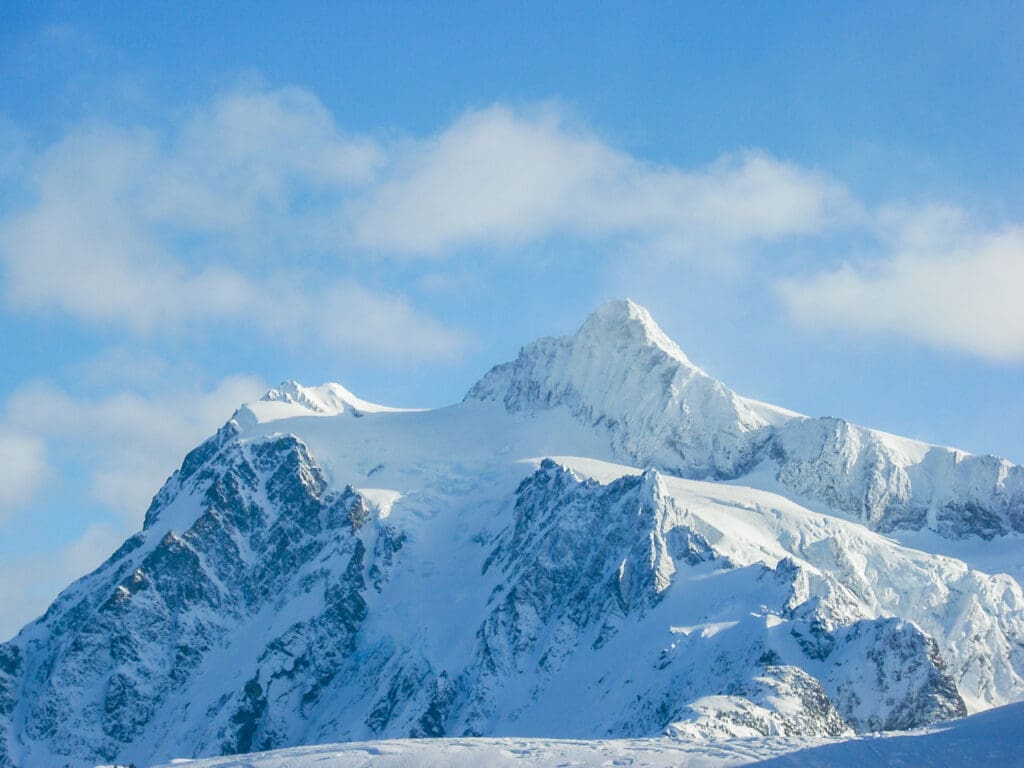
Mount Shuksan, North Cascades National Park, Washington.
Main attractions
Despite how remote the park may seem, it is just a few hour drive from Seattle or the city of Bellingham that lies to the west. Many of the main attractions of the park can be found within the Stephen Mather Wilderness. While nearly every national park requires an entrance fee, North Cascades National Park does not.
Highway 20 cuts through the middle of the park and is noted as being one of the most beautiful roads in all of America. While just outside the park, views from the Mount Baker Wilderness provide visitors with unobstructed views of Mount Shuksan from the iconic Artist’s Point Hike.
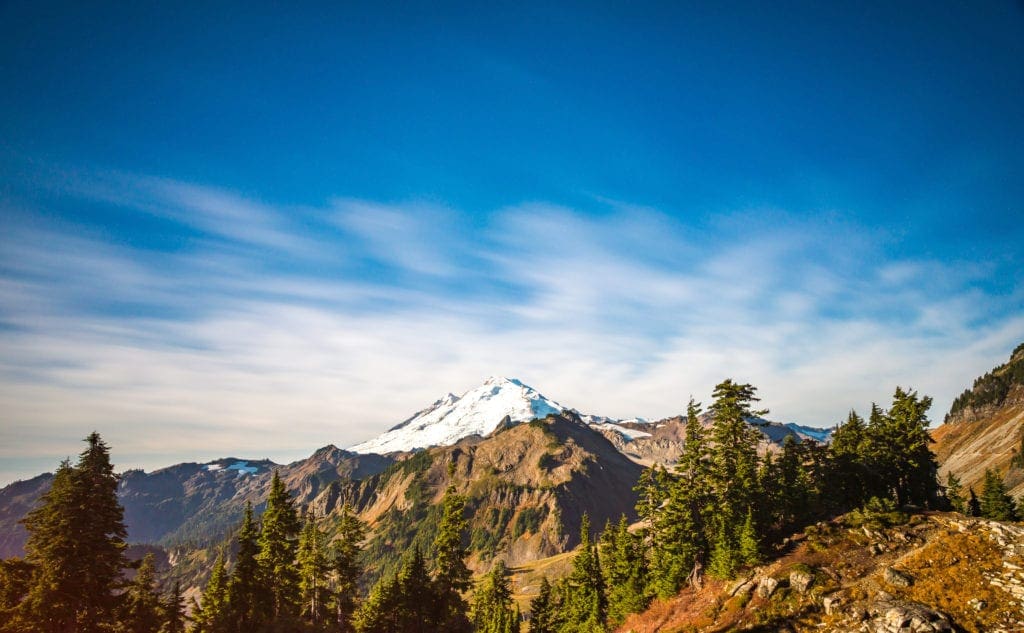
View of Mount Baker from the Artist Point hiking trail in North Cascades National Park, Washington.
Hiking:
-
Maple Pass Loop: This trail is praised for showcasing the park’s dramatic and wild beauty, including wildflowers, an alpine lake, and panoramic views of the craggy, glaciated peaks. It’s considered one of the best hikes in the North Cascades.
-
Blue Lake: Known for its family-friendly accessibility and leading to a beautiful mountain lake, Blue Lake is one of the most popular summer day hikes in the park.
-
Picture Lake Loop: Although not in the national park, this trail is highly scenic and offers easy access off SR-20, making it a popular choice for a shorter hike.
-
Ladder Creek Falls Trail: Leading to a stunning viewpoint of Diablo Lake, this is one of the most popular hikes in the area, with a fairly short and easy-going trail.
-
Cascade Pass Trail: This is one of the most popular trails in the North Cascades National Park, offering nearly 30 switchbacks and stunning views at the pass.
-
Sourdough Mountain: This trail is a more challenging day hike, leading to a ridge overlooking Lower Thornton Lake.
Each of these trails offers a unique experience, from panoramic views of the North Cascades to family-friendly walks to stunning alpine lakes. Remember to check trail conditions and closures before heading out, as some bridges may be taken down at the end of summer.
The park has over 400 miles of hiking trails, which also includes sections of the Pacific Crest Trail and the Pacific Northwest Trail. Snowshoeing is available on a few hiking trails during the winter months though access is limited due to snowfall and the lack of roads in the park.
The Dyrt: The Best Camping Near North Cascades National Park
Camping:
The North Cascades National Park is unique in the fact that there are no campgrounds that visitors can drive directly up to. Though there are various campgrounds along the iconic Highway 20, these are not technically in the park boundaries. Thus, all overnight camping within the park is considered backcountry camping.
North Cascades National Park offers an impressive selection of nearly 140 backcountry campsites, ranging from boat-accessible destinations to high alpine backpacking sites. It is important to note that camping is only allowed at designated locations along established trails. These campsites provide necessary amenities such as toilets and tent pads, and some even include convenient features like tables and firepits.
Permits are required for all backcountry sites and can be obtained at ranger stations on a first come, first served basis. From October 8th to mid-May, permits can also be self-issued at the Wilderness Information Center in Marblemount or the Golden West Visitor Center in Stehekin. For full trip planning information, visit the NPS Wilderness Trip Planner page.
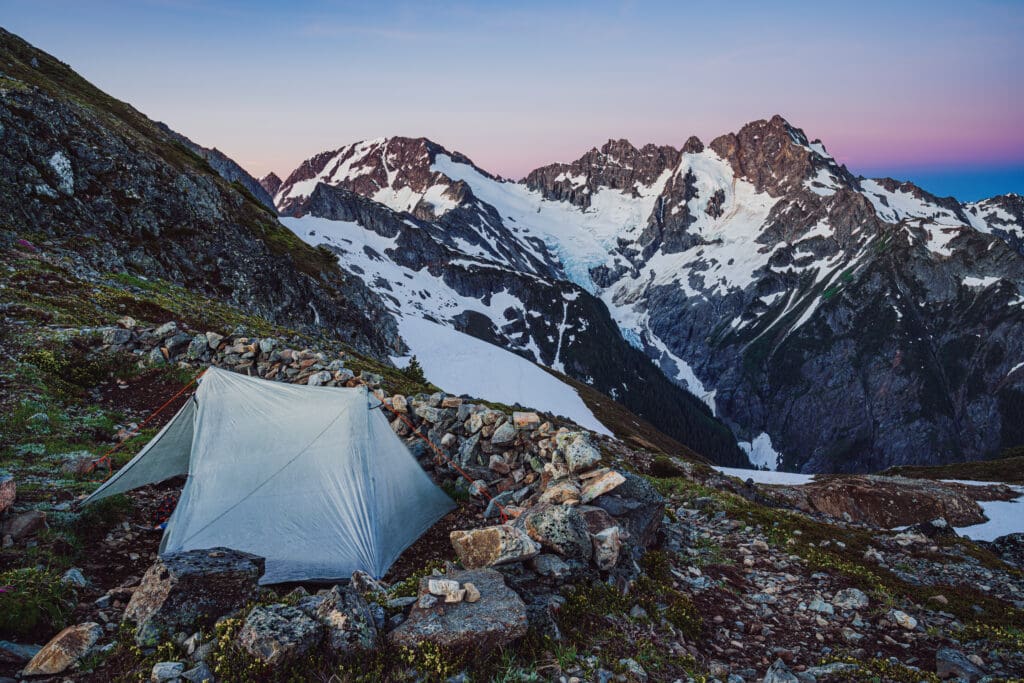
Cascade Pass is a popular area for backcountry camping in North Cascades National Park. Photo: Nathan/Adobe Stock.
Biking:
Biking in North Cascades offers a mix of thrilling and demanding experiences. From peaceful rides through the lower Stehekin Valley to challenging climbs on busy highways in the Skagit River gorge, there is something for every level of cyclist.
All roads open to public vehicles are also open to bicycles, but trails are off-limits. It’s important for cyclists to be prepared for changing weather conditions and carry necessary tools for any roadside repairs. The main cycling routes include State Route 20 (also known as North Cascades Highway), Stehekin Valley Road, and opportunities in the surrounding Skagit River and Methow River valleys.
Within the area, there are two designated spots for bicyclists to set up camp. One is located at Newhalem Creek Campground site A3 and the other is at Colonial Creek south site 115. These sites operate on a first-come, first-served basis and cannot be reserved in advance. However, after 8 pm, if the site remains unoccupied, vehicle owners may stay at the site for one night only. Cyclists can also find many camping options in Stehekin.
Climbing & Mountaineering:
Though the park isn’t home to the tallest peaks in the state, it is full of both climbing and mountaineering opportunities. The rugged peaks in North Cascades National Park will challenge even the most experienced climbers. While some of the popular peaks can be completed in a day, the more remote ones require a multi-day excursion. Much of the modern climbing routes were first set by Fred Beckey who in the 1930s-1950s was the first to summit over two dozen of the peaks within the region. When it comes to rock climbing the park has strict clean climbing rules meaning that no new fixed anchors can be placed. In order to protect the alpine region, climbers must use chocks and cams for climbing. Popular mountains and regions in the park include Eldorado Peak, Mount Shuksan, and Liberty Bell on Washington Pass.
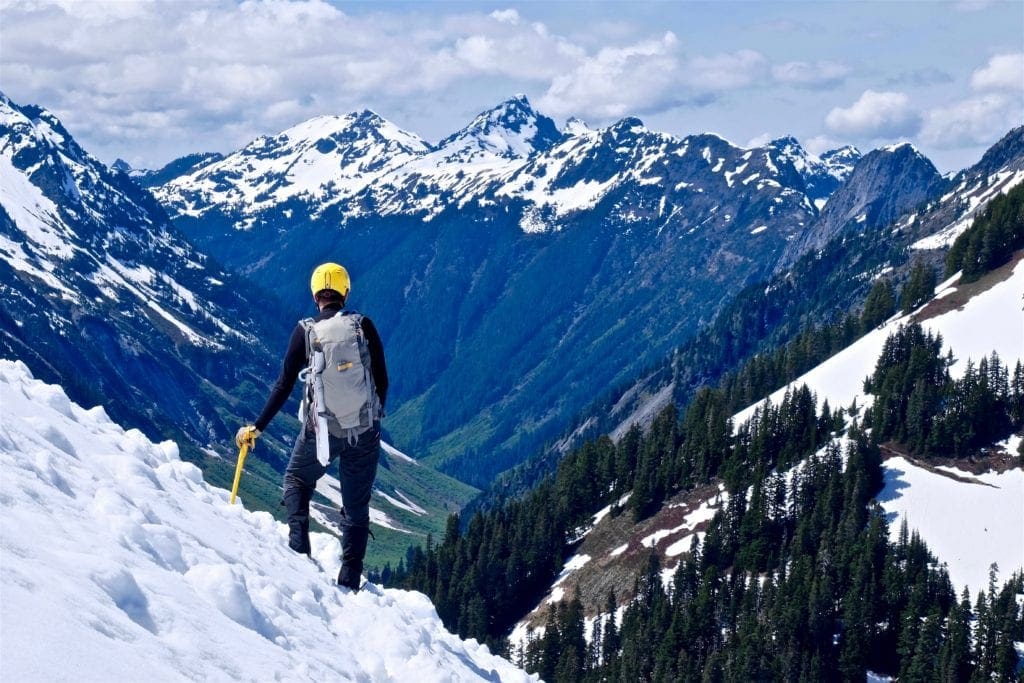
Mountaineer climbing in North Cascades National Park, Washington.
Stargazing
Stargazing in North Cascades National Park offers a unique and stunning experience for visitors. The park’s minimal light pollution and vast wilderness make it an ideal location for observing the night sky. Here are some key aspects to consider when planning a stargazing trip to North Cascades National Park.
For a perfect stargazing experience, consider visiting Diablo Overlook or Washington Pass Overlook. These easily accessible spots along Highway 20 provide unobstructed views of the night sky. Another great option is Artist Point at the end of the Mount Baker Highway. With its high elevation and striking mountain peaks in the background, this location is ideal for capturing breathtaking shots of the stars above.
For those interested in astrophotography, the North Cascades National Park presents a plethora of opportunities. The park’s dark skies make it ideal for astrophotography, providing a chance to capture mesmerizing images of the Milky Way and shooting stars during meteor showers. With long exposure techniques, photographers can capture stunning shots of the night sky in all its glory.
If you prefer a more structured experience, there are several stargazing tour options available. Local photographers offer Night Sky Photo Tours where they provide expert guidance on camera settings like aperture, shutter speed, and ISO. These tours also offer an opportunity to learn about the night sky while taking stunning photographs.
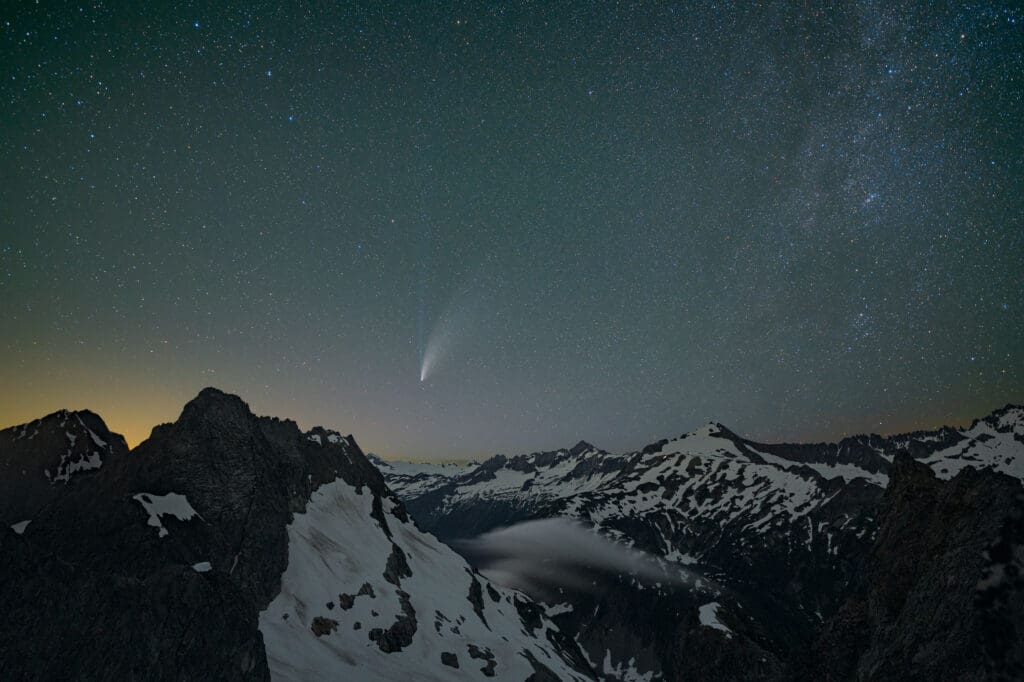
Stargazing in North Cascades National Park. Photo: Nathan/Adobe Stock.
Boating:
Boating on Lake Chelan, Diablo Lake, and Ross Lake in the North Cascades National Park offers a range of opportunities for water-based activities, each with their unique features and regulations to consider.
Lake Chelan is a 50.5-mile long lake that spans from the town of Chelan to the remote community of Stehekin. It’s a popular destination for boating and water sports. The lake is accessible by boat from the town of Chelan, and there are various boat rental services available in the area. The lake’s clarity and depth make it a prime location for various water activities, including fishing, water skiing, and paddle sports like kayaking and stand-up paddleboarding.
Diablo Lake is another popular destination for boating in the North Cascades National Park. It’s known for its stunning turquoise color, resulting from the surrounding glaciers grinding rocks into a fine powder that flows into the lake. There are boat-in camping sites on Diablo Lake, and the lake is accessible by boat from Colonial Creek Campground on State Route 20. Motorboats are allowed on Diablo Lake, but they must meet specific requirements, including using four-stroke engines, direct injection two-stroke engines, or equivalent technology.
Ross Lake is the third major water body in the North Cascades National Park. It’s a reservoir that extends into Canada and is surrounded by stunning mountain scenery. Ross Lake Resort offers boat rentals, including canoes, kayaks, and small powerboats. There are also boat-in camping sites available on Ross Lake. Motorboats on Ross Lake must also meet the same engine requirements as on Diablo Lake.
It’s important to note that personal watercraft, such as jet skis, are not allowed in any part of the North Cascades National Park Service Complex. All engines must meet 2006 EPA clean engine requirements.
For more information or to plan a boating trip, you can visit the National Park Service website or contact the Wilderness Information Center for backcountry permits if planning to camp on Ross Lake or Diablo Lake.
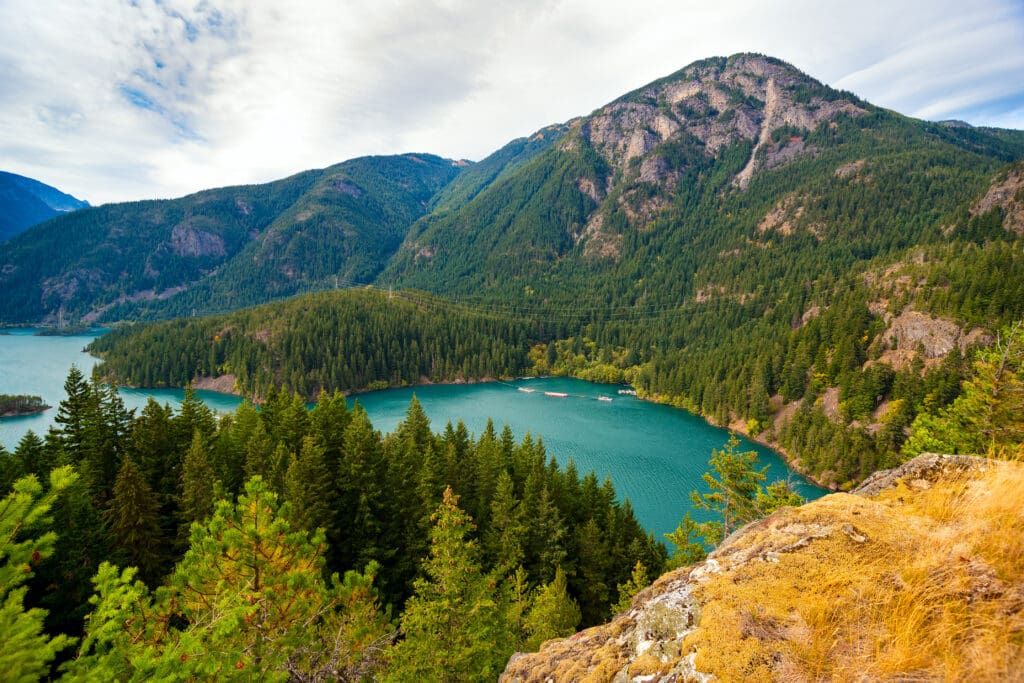
Diablo Lake in North Cascades National Park, Washington. Photo: Kenneth Sponsler/Adobe Stock.
Nearby Cities
Located an hour and a half west of the park lies the city of Bellingham. Nestled along the coast, the city has a population of over 90,000 people, making it the largest city within Whatcom County. With the North Cascades lying to the east, British Columbia to the north, and the San Juan Islands to the west, Bellingham is known for its abundance of outdoor activities. Home to some of the most extensive networks of mountain biking trails in the country, the city acts as a gateway to the North Cascades National Park as well as the rest of the peaks within the Northern Cascades.
An hour and a half south of Bellingham lies Seattle, the most populous city in the state. Though the park is only a few hours from Seattle, North Cascades National Park remains far less visited than Mount Rainier National Park or the national forests east of Seattle.
The North Cascades National Park is unlike any other park in the United States. It’s rugged peaks are more synonymous with those of Europe rather than North America. Yet despite the unparalleled beauty of the region, it still remains a protected yet hidden gem of the region. While fewer roads has allowed the wildlife to thrive and old growth forests to flourish, it has resulted in fewer people exploring this northern part of Washington. Whether visitors are looking for a scenic drive through the rugged peaks, or seeking solitude in the remote backcountry wilderness, the North Cascades National Park is sure to leave one wanting to come back for more.
Enroll With Global Rescue Prior To Embarking On Your Next Adventure.
When a travel emergency arises, traditional travel insurance may not come to your aid, and a medical evacuation can cost up to $300,000.
The cost when you have a Global Rescue membership? $0. That’s why when the unexpected happens, you want the leader in rescue, evacuation and medical advisory behind you. You want Global Rescue.




